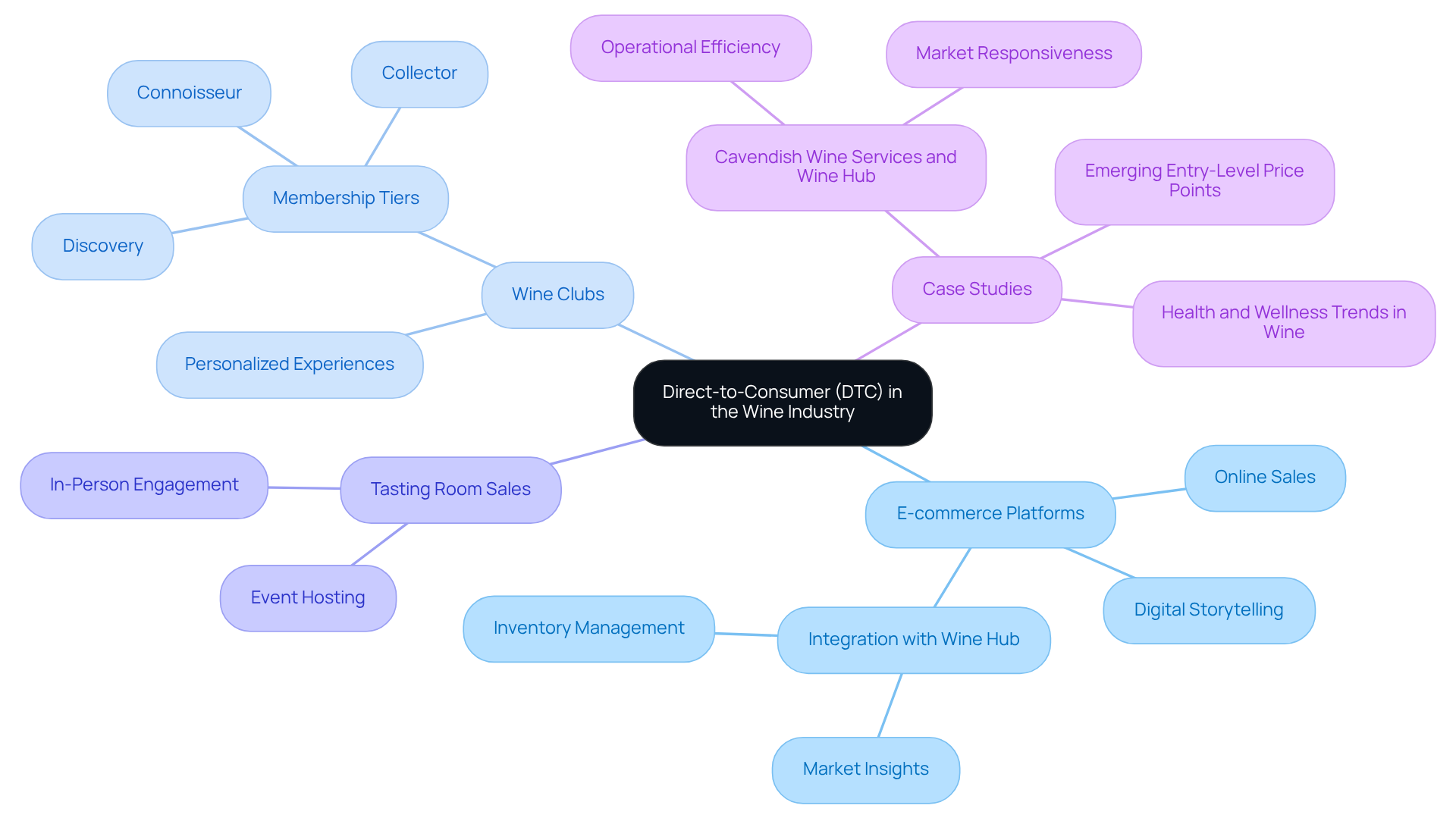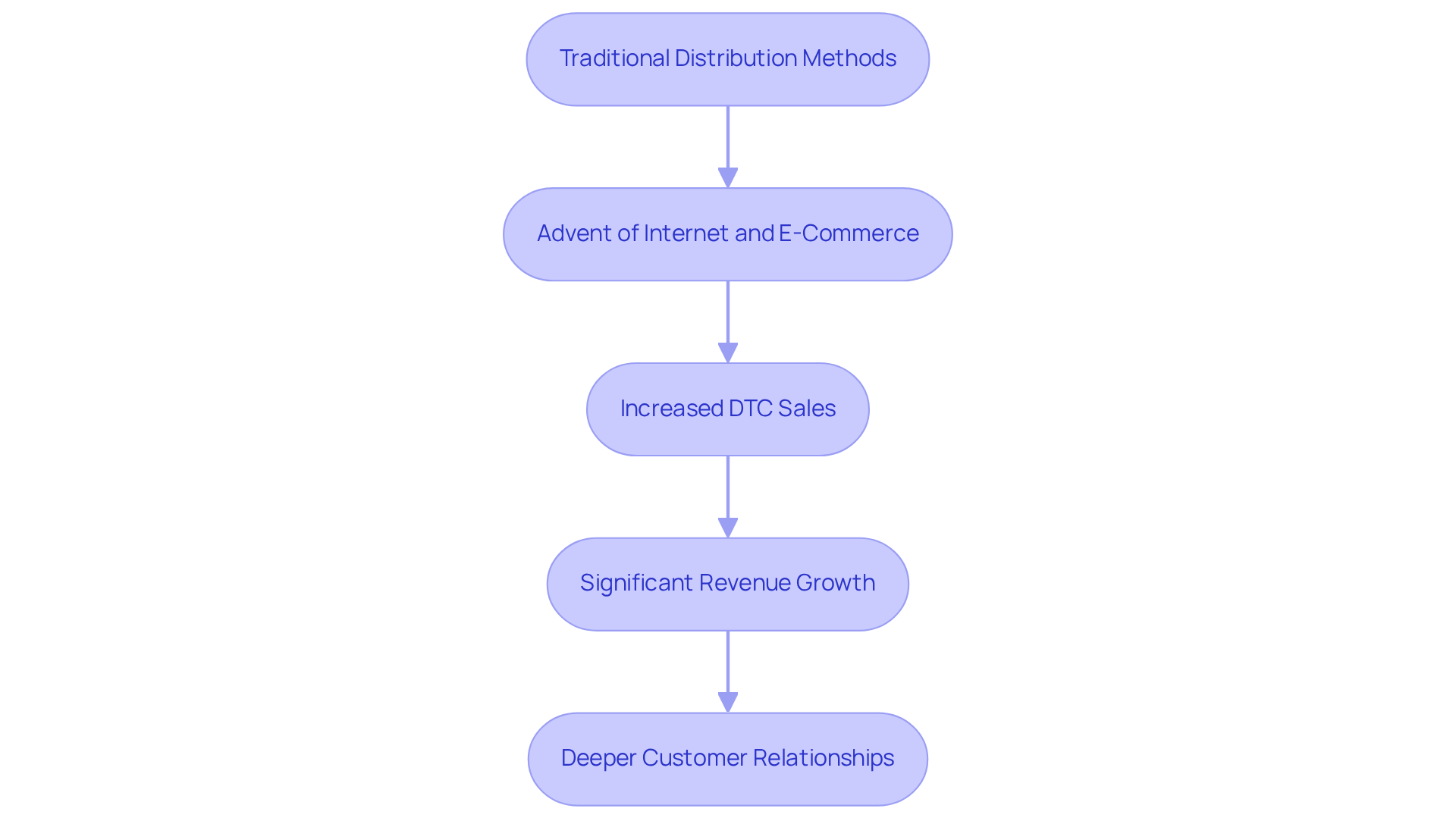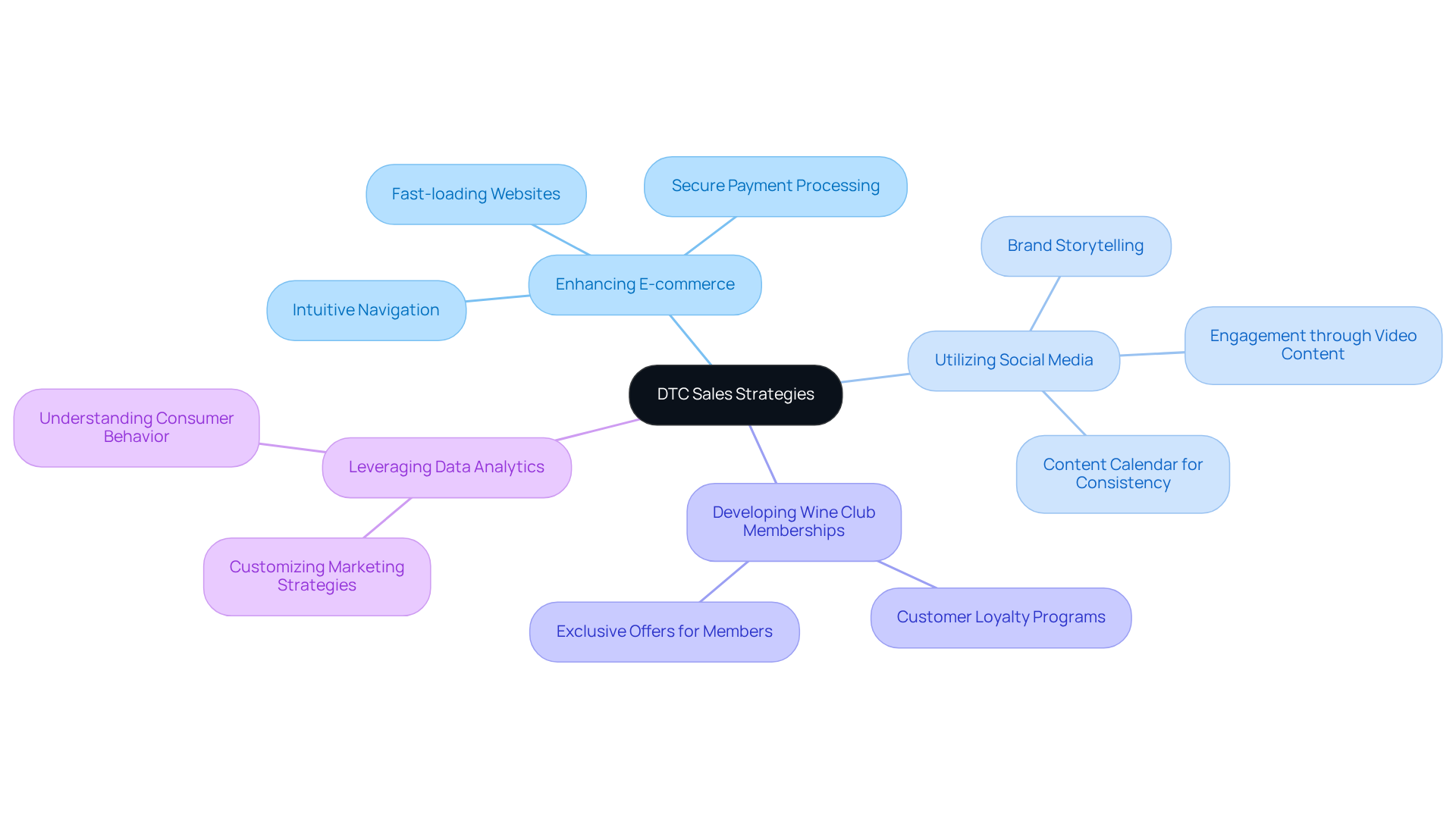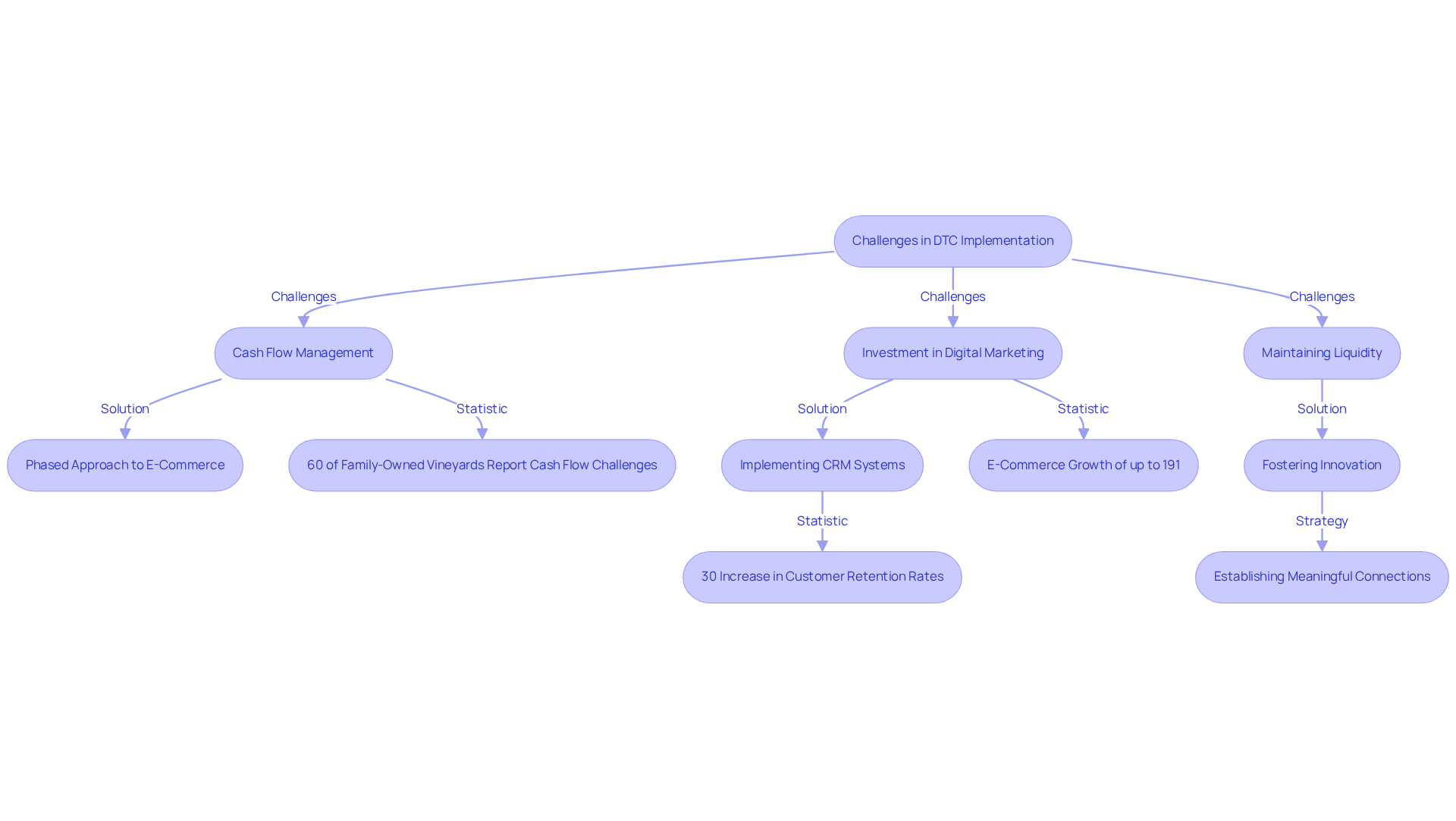Overview
This article delves into the pivotal role of the Direct-to-Consumer (DTC) sales strategy within the wine industry, underscoring its critical importance for the success of wineries. By enabling a direct connection with consumers, DTC fosters enhanced brand loyalty and allows wineries to swiftly adapt to shifting market dynamics. Supported by effective e-commerce strategies and robust customer engagement practices, DTC stands as an essential approach for modern wineries aiming to thrive in a competitive landscape. As the industry evolves, understanding and implementing DTC strategies will not only drive sales but also cultivate lasting relationships with consumers, ultimately leading to sustained growth and success.
Introduction
The wine industry is experiencing a transformative shift as wineries increasingly embrace Direct-to-Consumer (DTC) sales strategies, fundamentally redefining their customer connections. This innovative approach not only enhances brand loyalty but also provides wineries with invaluable insights into consumer preferences. By leveraging this data, they can craft personalized experiences that resonate deeply with their audience.
However, as the landscape evolves, wineries must confront a pressing question: how can they effectively navigate the challenges of implementing DTC strategies while maximizing their growth potential in a competitive market?
Defining Direct-to-Consumer (DTC) in the Wine Industry
The dtc in the wine sector represents a groundbreaking sales strategy that allows producers to engage directly with buyers, eliminating traditional distribution intermediaries such as wholesalers and retailers. This innovative method fosters a direct connection with clients, enhancing brand loyalty and offering invaluable insights into consumer preferences. DTC encompasses a range of sales techniques, including e-commerce platforms, wine clubs, and tasting room sales, enabling wineries to create personalized experiences that resonate with their audience through compelling storytelling.
The significance of the DTC sales is highlighted by its adaptability to evolving consumer behaviors, particularly the increasing inclination towards online shopping and customized experiences. Wineries that implement the dtc can substantially amplify their market presence and customer engagement. A case in point is Cavendish Wine's adoption of Wine Hub, which illustrates how technology integration can streamline operations and refine pricing strategies, ultimately strengthening customer relationships and operational efficiency.
Effective strategies in the DTC often involve developing robust e-commerce platforms, enhancing wine club memberships, and employing efficient demand generation techniques. These strategies not only drive immediate sales growth but also cultivate long-term customer loyalty through captivating brand narratives. As the wine sector evolves, embracing the dtc becomes essential for vineyards aiming to thrive in a competitive landscape, ensuring they remain connected to their most devoted patrons. Furthermore, in light of recent tariff changes impacting the wine market, producers must adapt their strategies for the DTC to navigate these challenges effectively, ensuring their storytelling resonates with buyers during these transitions.

The Evolution and Importance of DTC for Wineries
The evolution of the dtc strategies in the wine industry is nothing short of remarkable. Initially, wine producers relied heavily on traditional distribution methods, which often limited their ability to connect with consumers. However, the advent of the internet and e-commerce has revolutionized how wineries engage with their clientele. Today, the dtc sales are increasingly vital, representing a significant share of winery revenues. Recent statistics reveal that vineyards embracing the dtc can achieve e-commerce growth rates as high as 191%. This transformation not only enables wineries to enhance their sales but also fosters deeper relationships with customers, allowing them to convey their brand stories and values directly. As the landscape continues to shift, wineries must adapt to these changes to thrive in a competitive market.

Key Strategies for Implementing DTC Sales Channels
Implementing successful sales channels in the DTC necessitates a multifaceted strategy. Wineries must prioritize enhancing their e-commerce platforms to provide a smooth shopping experience, essential in today's market where shoppers expect fast-loading websites and intuitive navigation.
Furthermore, utilizing social media for brand storytelling is critical; captivating narratives about the establishment's heritage and values significantly improve customer connection and drive sales. For instance, vineyards that effectively leverage social media have reported a remarkable 27% increase in new wine club registrations through digital channels, underscoring the impact of targeted online marketing.
Additionally, developing engaging wine club memberships fosters customer loyalty, while data analytics, particularly the DTC, plays a pivotal role in understanding consumer behavior and preferences. By customizing marketing strategies based on these insights, producers can craft engaging experiences that resonate with their audience, ultimately leading to sustained growth in an increasingly competitive market.
Enocap offers demand generation approaches and customer retention initiatives that can further enhance these efforts, along with strategic capital planning to ensure businesses are well-positioned for future growth.

Challenges and Solutions in DTC Implementation
Wineries aiming to implement the DTC often face significant challenges, particularly in cash flow management. Statistics reveal that cash flow issues are prevalent among family-owned vineyards, with many struggling to maintain liquidity while investing in essential digital marketing and e-commerce initiatives. A study found that approximately 60% of family-owned vineyards reported cash flow challenges, underscoring the urgency of addressing this matter. Moreover, with 4.1 million online wine buyers in 2020, the potential for growth in the DTC market is substantial.
To effectively tackle these challenges, establishments can adopt a phased approach to the DTC implementation. Initiating small-scale e-commerce initiatives allows for manageable growth and minimizes risk. As confidence and experience build, establishments can gradually expand their DTC efforts. Enocap's extensive advisory offerings, which include demand generation techniques and wine club enhancement, can support this process, providing proven strategies that have enabled vineyards to achieve e-commerce growth of up to 191%.
Investing in customer relationship management (CRM) systems presents another effective strategy. These systems empower vineyards to monitor customer interactions and preferences, facilitating tailored marketing strategies that resonate with their audience. For instance, a vineyard that implemented a CRM system reported a 30% increase in customer retention rates, illustrating the potential impact of personalized engagement.
Additionally, fostering a culture of innovation and adaptability is essential. Wineries that embrace change and continuously seek to improve their operations are better positioned to navigate the complexities of the DTC. By leveraging data-informed insights and focusing on customer connections, establishments can not only address cash flow challenges but also thrive in an increasingly competitive market. Establishing meaningful connections with end consumers is vital, as it fosters loyalty and encourages repeat business, further stabilizing cash flow. Furthermore, Enocap's strategic capital planning services can assist wineries in securing the right partners and capital, ensuring sustainable growth for generations.

Conclusion
The direct-to-consumer (DTC) approach in the wine industry signifies a transformative shift that empowers wineries to forge more meaningful connections with their customers. By eliminating traditional intermediaries, wineries enhance brand loyalty and harness valuable consumer insights that drive their marketing strategies. For wineries seeking to thrive, embracing DTC is no longer optional; it is a vital component of success in a rapidly changing marketplace.
This article has explored key strategies for implementing DTC sales channels, emphasizing the importance of robust e-commerce platforms, engaging wine club offerings, and effective storytelling through social media. The evolution of DTC is underscored by impressive growth statistics, demonstrating that wineries adopting these strategies can significantly boost revenues while fostering deeper relationships with their clientele. Challenges such as cash flow management have also been addressed, highlighting the necessity for wineries to adopt innovative solutions and a phased approach to DTC implementation.
Ultimately, the significance of DTC in the wine industry transcends mere sales figures; it centers on building lasting connections with customers and adapting to their preferences. As the landscape continues to evolve, wineries must remain agile and innovative, leveraging data-driven insights to enhance their offerings. By prioritizing DTC strategies, wineries can navigate current challenges and position themselves for sustained growth and success in the future. Embracing this approach is essential for any winery aiming to cultivate a loyal customer base and thrive in a competitive environment.
Frequently Asked Questions
What is Direct-to-Consumer (DTC) in the wine industry?
DTC in the wine industry refers to a sales strategy that allows producers to sell directly to buyers, bypassing traditional distribution intermediaries like wholesalers and retailers. This approach fosters a direct connection with clients and enhances brand loyalty.
What are some sales techniques included in DTC?
DTC encompasses a variety of sales techniques, including e-commerce platforms, wine clubs, and tasting room sales. These methods enable wineries to create personalized experiences for their customers.
How does DTC benefit wineries?
DTC benefits wineries by amplifying their market presence and customer engagement. It allows them to gain valuable insights into consumer preferences and adapt to evolving shopping behaviors, particularly the shift towards online shopping and customized experiences.
Can you provide an example of a winery using DTC effectively?
An example is Cavendish Wine's adoption of Wine Hub, which demonstrates how integrating technology can streamline operations, refine pricing strategies, and strengthen customer relationships.
What strategies are effective in implementing DTC?
Effective strategies for DTC include developing robust e-commerce platforms, enhancing wine club memberships, and employing efficient demand generation techniques. These strategies drive immediate sales growth and foster long-term customer loyalty.
Why is DTC important for vineyards in a competitive landscape?
Embracing DTC is essential for vineyards to thrive in a competitive landscape, as it ensures they remain connected to their most devoted patrons and can adapt to market changes, such as recent tariff adjustments impacting the wine market.
How should wineries adapt their DTC strategies in light of market changes?
Wineries should adapt their DTC strategies by ensuring their storytelling resonates with buyers and by adjusting their operations to navigate challenges effectively, such as those posed by recent tariff changes.




